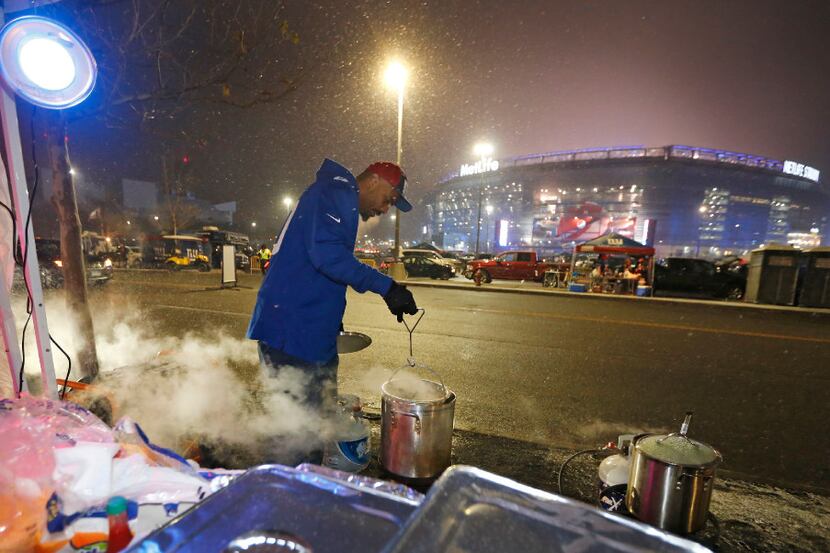Editor’s note: This article first appeared in The Dallas Morning News on Nov. 15, 2000.
John Bass cooks four turkeys in the time it takes most folks to cook one. His secret? Frying. It's an outdoor job, and that suits the retired rancher just fine. But what prods Mr. Bass to fry isn't mere love of outdoor cooking. It's the results.
"It's unbelievably moist and not at all greasy," says Mr. Bass. "The peanut oil gives the turkey a slightly nutty flavor."
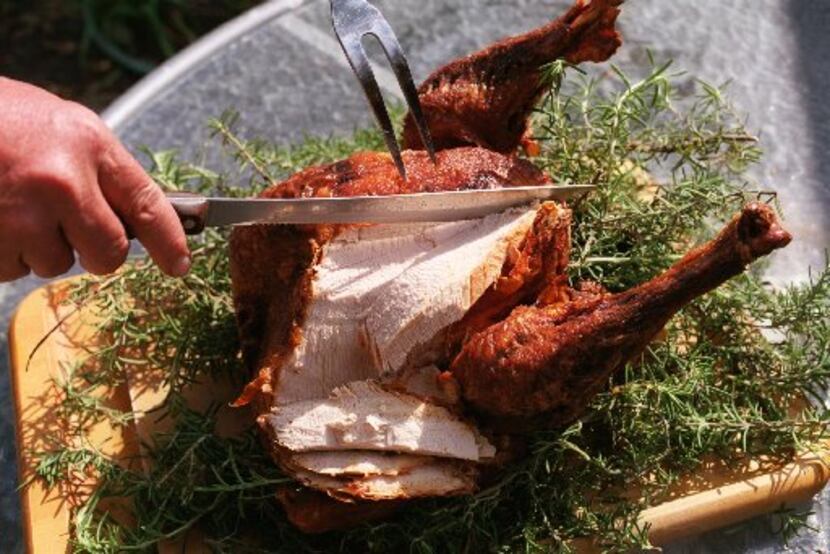
Dallas has been buying Cajun fried turkeys for several years. Now, more people are tackling the job at home; even Dillard's sells the gear for frying a turkey.
We spent an afternoon watching Mr. Bass fry turkeys — a valuable lesson, because this type of cooking can be dangerous. We consulted other experts as well, to come up with a guide for safe and successful turkey frying in your back yard.
A step-by-step guide
Where to fry safely
Frying a turkey isn't hard. The only prerequisite is being a stickler for safety. Since frying involves a high-powered burner and gallons of hot oil, it must be done outdoors, away from children, pets and flammable products. Mr. Bass fries his turkey on the back patio - and he's got the grease stains in the concrete to prove it.
To avoid grease stains, cover a 5x5 area of the patio or deck with cardboard, says Greg Garofalo, manager of Barbeques Galore on Lovers Lane. "Place the burner in the center of the cardboard and it will hold it down, unless it's a real windy day," he says. If it is gusty, anchor the corners with rocks.
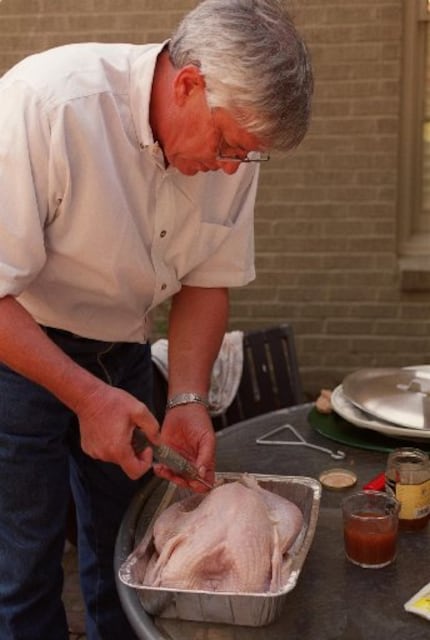
If it rains, scrap the project unless you have a covered patio. "It should have a minimum of a 10-foot-high ceiling and at least two open sides for proper ventilation," Mr. Garofalo says.
Under no circumstances should you bring the project indoors. "That's a good way to catch your house on fire," says Mr. Bass. And don't even think about using your garage: It's potentially the most dangerous spot.
What to buy
Use special turkey-frying equipment to avoid accidents. Here's what you'll need:
A 130,000 to 165,000 BTU burner: A high-powered burner is necessary to heat the oil.
A large, narrow fryer-steamer pot: This is the most oil-efficient, economical option. Here's how to choose the right size pot:
- 26-quart: for frying a 12- to 14-pound turkey
- 34-quart: for frying a 14- to 20-pound turkey
- 40-quart: for turkeys larger than 20 pounds.
Some people use a deep cast-iron pot or kettle, but these use more oil since they are wider. If you have one, it should be deep enough to accommodate the turkey on a stand, with room for oil to cover it and several inches of clearance for oil bubbling up as it heats.
Turkey stand and lifter: These are usually sold together. They enable you to safely transfer the turkey into and out of the pot, without dropping it into the hot oil. Some people use the steamer baskets that come with the large steamer-fryer pots, but there's no easy way to remove the turkey without risking dropping it.
Long-stemmed, clip-on deep-fry thermometer: This should be at least 12 inches long. They are sold both individually and in kits along with the fryer pot, turkey stand and lifter.
Injector: This is a syringe used for injecting flavored marinade into the turkey meat. You don't have to inject a turkey to fry it, but it adds flavor.
Heavy-duty leather work gloves: A must, since equipment gets skin-blistering hot, and grease may splatter on your hands. Cotton gloves aren't sufficient protection.
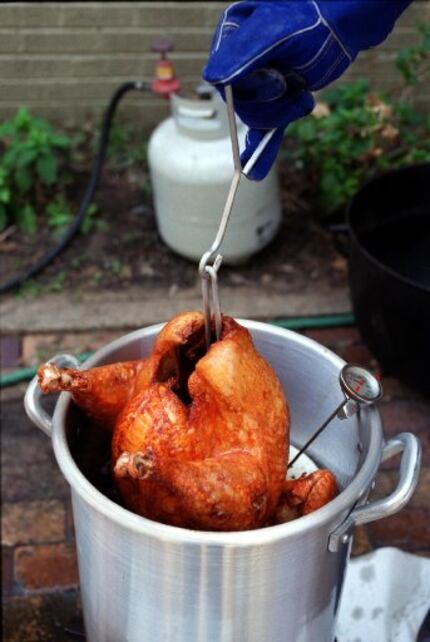
Instant-read meat thermometer: Unless you have lots of experience, using a thermometer is the best way to confirm doneness.
How much oil to buy
Place your turkey in the frying pot and add water to cover by an inch or two (this can be done with the turkey wrapper on). There's no need to put the turkey on the stand when immersing it in cold water. Remove the turkey and return it to the refrigerator, then measure the water that's in the pot, or mark the water level on the pot with a piece of removable colored tape. You'll need the same amount of oil to cover the turkey. Mr. Garofalo estimates that for a 12- to 14-pound turkey cooked in a narrow, 26-quart fryer-steamer pot you'll need 2-1/2 to 3 gallons of oil.
What to wear: Because grease splatters can lead to bad burns, wear clothing that covers your whole body - closed-toed work shoes or boots, jeans, a long-sleeved shirt and leather work gloves - no matter how hot it is outdoors.
Before you cook: Prepare your bird: Allow time for your turkey to completely defrost in the refrigerator (24 hours for every 5 pounds). Remove the packaging, giblets and plastic pop-up button (if applicable).
Traditionally, a fried turkey is injected with a marinade before it's cooked; how long before cooking is a subject of debate. You can inject the turkey anywhere from 24 hours to 5 minutes before frying. We had good results injecting two hours before frying.
Mr. Bass likes to coat his turkeys in a Cajun dry rub or hot sauce hours before frying. Although it doesn't add much flavor to the meat, it gives the fried bird a beautiful color. Mr. Garofalo doesn't treat the outside of his turkeys, but he suggests using a dry rub rather than a liquid, to avoid excessive grease splatters when a wet turkey is lowered into the hot oil.
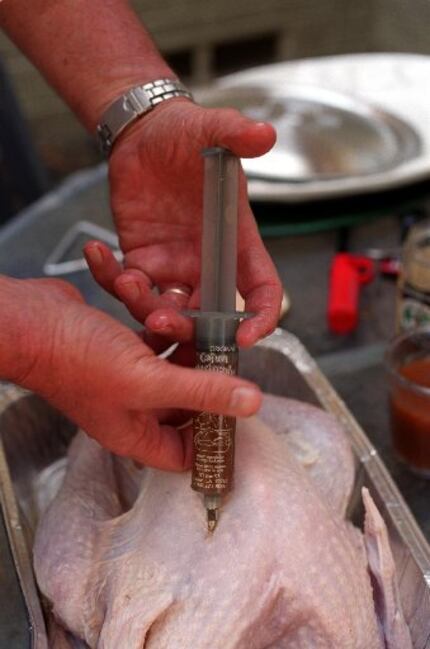
What and how to inject: You can buy bottled injection marinades at most supermarkets or at an outdoor cooking store. Some folks even inject bottled Italian salad dressing into their turkey, or make their own injection marinades. We had good results using Chef William's Creole Butter and Mr. C's. If you like a spicy Cajun flavor, try Bayou Buttery Gold's marinade (available at Barbeques Galore).
Mr. Bass uses almost an entire 12-ounce bottle of marinade for a 13-pound turkey. He injects in several points on each leg, thigh and breast. As he injects the liquid, he slowly retracts the needle from the bird to allow the marinade to penetrate a wider area.
Trussing: Strictly optional
Mr. Bass has fried both trussed and untrussed turkeys; the difference is a matter of aesthetics. If you prefer the look of a trussed bird, use baling wire instead of cooking twine to hold the legs in place; the wire withstands the high oil temperatures best.
Drying the turkey: After injecting the turkey, pat it dry, inside and out. The water and juices that accumulate inside the turkey and the marinade that seeps out can cause the oil to splatter as the turkey is lowered into the pot.
Refrigerating the turkey: Keep raw turkeys refrigerated until you are ready to cook them, says Sherrie Rosenblatt, spokeswoman of the National Turkey Federation. This is especially relevant if you are going to be frying several turkeys in succession. If you want to have your turkey close at hand while you are heating the oil, she recommends placing it in a cooler with lots of ice. "Remember to wash your hands after you handle the raw turkey," says Ms. Rosenblatt.

Cooking the turkey
Heating the oil: Set the frying pot on the burner. Be sure that the burner is turned off while you pour oil into the pot. Pour the amount of oil calculated earlier when you measured the water needed to cover the turkey. Clip the frying thermometer to the side of the pot. Turn the burner to high and heat until the oil registers 350 F. Do not leave the burner unattended for even a second; a breeze could blow something flammable into the flame, or someone could come dangerously close to the equipment. To heat 3 gallons of oil (enough for a 13-pound bird), count on 15 to 30 minutes.
Lowering the turkey: Under no circumstances should you place the turkey in the oil without the aid of a turkey lifter or basket. "You'll wind up at Baylor [hospital] if you accidentally drop that turkey in the hot oil," says Mr. Bass. And don't try to rig your own turkey lifter.
Placing the turkey on the stand is easy: The cavity slips right over the center piece. The accompanying turkey lifter hooks onto the handle of the turkey stand; this hook allows you to safely lower the turkey into the oil. Always wear gloves when lifting the turkey, since grease will splatter.
As a safety precaution, Mr. Garofalo recommends turning the burner down to the lowest setting (or off) while you slowly and gently lower the turkey into the oil. This reduces the risk of injury or fire in the event that oil splatters over the sides of the pot (which is common), or the pot is knocked over. Once the turkey is in the pot, remove the lifter from the stand, and place it where it is out of reach from unprotected hands.
Regulating the oil temperature: As soon as the turkey enters the oil, the oil temperature will immediately fall by at least 15 degrees. Once the turkey is safely submerged and the oil stops splattering, Mr. Garofalo turns the heat up to high again. Within five minutes, he says, 3 gallons of oil should return to 350 F. (It will take longer for larger turkeys, cooked in more oil). At 350 F, he turns the burner to a medium to medium-high flame. He checks the temperature every five minutes, regulating the heat to maintain 350 F.
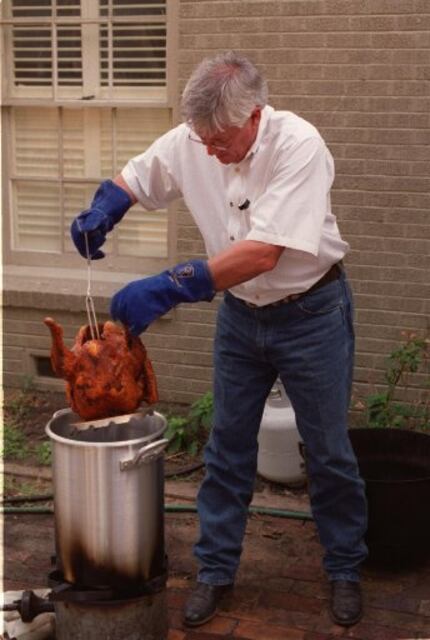
How long to fry: Typically, Mr. Bass fries the turkey for about 31/2 minutes per pound. But since it's hard to maintain a constant oil temperature, he sometimes adds four or five extra minutes to the calculated cooking time.
"You can't tell by looking at the bird if it's done," he says, noting that the turkey turns a beautiful golden color on the outside when it's still raw inside. The finished turkey will have crispy-looking, even wrinkled, skin, and registers 160 degrees F when a meat thermometer is inserted into the thickest part of the breast.
"My meat thermometer paid for itself," says Mr. Bass.
Mr. Garofalo doesn't use a meat thermometer. Instead, he fries his turkeys for closer to 4 minutes per pound plus an additional 5 minutes, to compensate for the drop in temperature that occurs as the turkey is first placed in the fryer. Using this method and maintaining a near-constant 350 F temperature, he's never had to put a turkey back in for more frying.
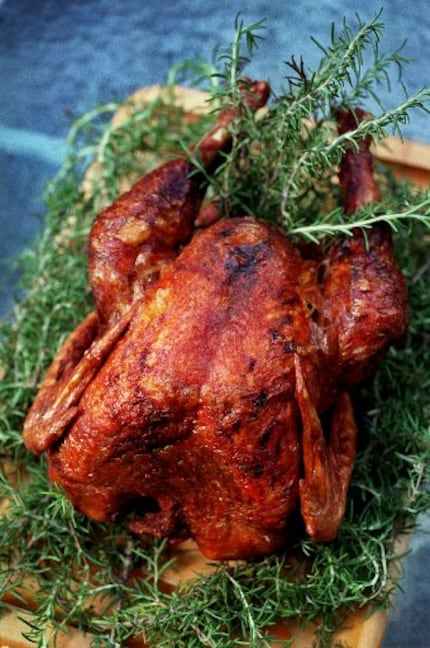
To test for doneness, remove the turkey from the fryer and ontoa work surface. Lift the turkey stand from the pot (wearing glovesand using the safety hook). Hold the stand over the pot for a fewseconds to allow the excess oil to drain. Carefully move the basketto a work surface covered with paper grocery bags or severalthicknesses of newspapers to absorb the grease. Insert aninstant-read thermometer into the thickest part of the breast. Itshould register 160 degrees. If the reading is lower than 160, putthe bird back into the fryer for a few more minutes.
Don't forget to turn off the burner after removing theturkey.
When the turkey is done, let the turkey rest for a few minuteson the stand. Then, wearing gloves, remove the turkey from thestand and place it on the prepared work surface to drain (cover anarea of the papered surface with paper towels to help absorb thegrease). Transfer to a platter or carving board. Allow the turkeyto rest for 20 minutes before carving.
Leftover oil
Remember when you go inside to eat that you still have a largevat of hot oil cooling in the yard; make sure pets and kids can'tget to it.
The oil can be reused if it’s filtered. Purchase filteringequipment at an outdoor cooking store or a restaurant supply store.Store the oil, tightly covered, away from heat. The oil does notkeep indefinitely. Smell it before reusing to be sure it isn’trancid.
